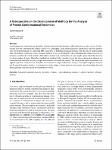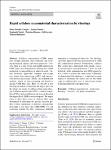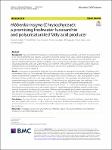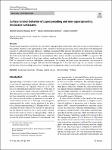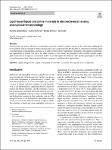Search
Author
- Carlos, Alegría (2)
- Carlos, Seara (2)
- David, Orden (2)
- Klaus, Bretterbauer (2)
- next >
Subject
Date issued
Has File(s)
- true (287)
Search Results
Magnetic hyperthermia (MHT)-mediated thermal ablation therapy has promising clinical applications in destroying primary tumours. However, traditional MHT still presents the challenges of damage to normal tissues adjacent to the treatment site and the destruction of tumour-associated antigens due to its high onset temperature (> 50 °C). In addition, local thermal ablation of tumours often exhibits limited therapeutic inhibition of tumour metastasis. |
In this study, a highly effective hybrid adsorbent composite based on low-cost fuller’s earth (FE), aluminum silicate (AS) and chitosan (CS) was prepared using a facile method. The prepared composite was applied to adsorb lead (Pb2+) and copper (Cu2+) ions from aqueous solutions. Several analyses such as Fourier transform infrared spectroscopy (FTIR), Scanning electron microscopy (SEM) and X-ray diffraction (XRD) were used to characterize the composite. The adsorption efficiency of the prepared composite was investigated at different operating conditions. Moreover, the adsorption isotherm/kinetic models and adsorption thermodynamics of the composite were examined. |
Analysing protein conformational ensembles whether from molecular dynamics (MD) simulation or other sources for functionally relevant conformational changes can be very challenging. In the nineteen nineties dimensional reduction methods were developed primarily for analysing MD trajectories to determine dominant motions with the aim of understanding their relationship to function. Coarse-graining methods were also developed so the conformational change between two structures could be described in terms of the relative motion of a small number of quasi-rigid regions rather than in terms of a large number of atoms. |
Cellulose nanomaterial (CNM) aspect ratio strongly influences sheet formation and resulting mechanical, optical, and barrier properties. However, there is a lack of fast and reliable methods for CNM aspect ratio determination, limiting the reliable production of nanocellulose at industrial-scale. Current laboratory approaches comprise microscopic (e.g. atomic force microscopy (AFM) and transmission electron microscopy (TEM)), and sedimentation methods, which are time-consuming and limited to specific CNM fibre sizes. Here, we describe a new rheological method to determine the aspect ratios for the whole size range of cellulose fibres using rheology. Cellulose nanocrystals (CNCs), cellulose nanofibres (CNFs), and wood fibres in the form of Bleached Eucalyptus Kraft (BEK) were investi... |
In this work, Ag0.5Cr2.5O4 nanochromite is fabricated utilizing a simple process (flash technique) at various annealing temperatures (room and 900 °C). The particle sizes of the materials under study were shown to be in the nanoscale range by atomic force microscopy (AFM) and field emission scanning electron microscopy (FESEM). Fourier transform infrared (FTIR) analysis was performed to verify the fabrication of the examined nanosamples and evaluate the bands behavior. The tetrahedral A-site (622.9 cm−1 for room temperature, 630.6 cm−1 for 900 °C) and the octahedral B-site (557.3 cm−1 for room temperature, 563.1 cm−1 for 900 °C) were the two prominent bands measured by FTIR analysis. The elastic characteristics of Ag0.5Cr2.5O4 nanoparticles were examined using FTIR measurements, rev... |
Electrochemical water splitting is a promising pathway for effective hydrogen (H2) evolution in energy conversion and storage, with electrocatalysis playing a key role. Developing efficient, cost-effective and stable catalysts or electrocatalysts is critical for hydrogen evolution from water splitting. Herein, we evaluated a graphene-modified nanoparticle catalyst for hydrogen evolution reaction (HER). The electrocatalytic H2 production rate of reduced graphene oxide-titanium oxide-nickel oxide-zinc oxide (rGO–TiO2–NiO–ZnO) is high and exceeds that obtained on components alone. This improvement is due to the presence of rGO as an electron collector and transporter. Moreover, a current density of 10 mA/cm2 was recorded at a reduced working potential of 365 mV for the nanocomposite. T... |
Algae are prominent producers of carotenoids and polyunsaturated fatty acids which are greatly prized in the food and pharmaceutic industry. Fucoxanthin represents a notable high-value carotenoid produced exclusively by algae. Its benefits range far beyond just antioxidant activity and include cancer prevention, anti-diabetes, anti-obesity, and many other positive effects. Accordingly, large-scale microalgae cultivation to produce fucoxanthin and polyunsaturated fatty acids is still under intensive development in the commercial and academic sectors. Industrially exploitable strains are predominantly derived from marine species while comparable freshwater fucoxanthin producers have yet to be explored. |
Diabetic nephropathy (DN) represents a major diabetes-related complication, which could undermine renal function. CircCOL1A2 has been previously reported to show abnormal expression during DN. However, its functional role in the progression of DN, as well as the potential molecular mechanisms, remains unclear. The present work examined the expression of circCOL1A2 in the plasma of DN patients, and employed high glucose (HG)-challenged HK-2 cells as the in vitro cell model of hyperglycemia (HG)-induced DN. CircCOL1A2 was silenced using siRNA in HK-2 cells to clarify the functional engagement of circCOL1A2 in HG-induced DN. We examined the roles of circCOL1A2 in regulating oxidative stress by measuring reactive oxygen species (ROS), lipid peroxidation, and superoxide dismutase (SOD) l... |
One parameter frequently considered to be relevant for superspreading of trisiloxane surfactants is surface tension kinetics. In the scientific literature, some experimental results reported for trisiloxane surfactants are in contradiction with fundamental concepts of surfactant monomer diffusion. Therefore, maximum bubble pressure tensiometry has been used to determine dynamic surface tension (DST) of two types of trisiloxane surfactants: superspreader and non-superspreader. Results show that both surfactants behave similarly at concentrations below critical micelle concentration (CMC), as expected. The CMC curves, as determined by drop shape analysis, confirmed that the more hydrophilic non-superspreader has a higher CMC as compared to the more hydrophobic superspreader. |
Some biologically active substances are unstable and poorly soluble in aqueous media, at the same time exhibiting low bioavailability. The incorporation of these biologically active compounds into the structure of a lipid-based lyotropic liquid crystalline phase or nanoparticles can increase or improve their stability and transport properties, subsequent bioavailability, and applicability in general. The aim of this short overview is (1) to clarify the principle of self-assembly of lipidic amphiphilic molecules in an aqueous environment and (2) to present lipidic bicontinuous cubic and hexagonal phases and their current biosensing (with a focus on electrochemical protocols) and biomedical applications. |



